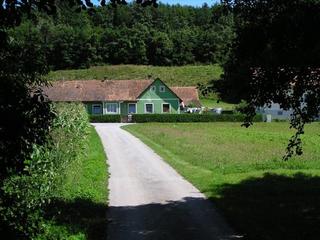|
Austria
1.9 km (1.2 miles) S of Tautendorf bei Fürstenfeld, Steiermark, Austria
Approx. altitude: 283 m
(928 ft)
([?] maps: Google MapQuest OpenStreetMap ConfluenceNavigator)
Antipode: 47°S 164°W
Accuracy: 5 m (16 ft)
Quality: good
Click on any of the images for the full-sized picture.
| 47°N 16°E (visit #4) |

(visited by Werner Furlan, Susanne Furlan, Raphael Furlan and Katharina Furlan) 23-Aug-2004-- Endlich war es soweit, unser lang erwarteter Urlaub sollte beginnen. Das Ziel war Bad Tatzmannsdorf in Burgenland. Von Graz starteten wir und wie konnte es anders sein, Werner hatte die Route so gewählt, daß sie am Confluencepunkt 47N 16E vorbeiführte. Zuerst besuchten wir aber die größte Tropfsteinhöhle Österreichs, der Lurgrotte. Im Sommer gibt es Führungen über eine oder zwei Stunden, im Winter kann man sogar 4h weit in die Höhle vordringen, weil dann der Wasserstand niedriger ist und keine Gefahr der Überflutung besteht. Nach dem großen Hochwasser von 1989 ist die Höhle nun wieder ohne Probleme zu besichtigen. Dann ging es weiter nach Osten. Es war eine wunderschöne Fahrt durch die hügelige Oststeiermark. Dieser Teil Österreichs ist sehr fruchtbar und landwirtschaftlich geprägt. Berühmt ist der Anbau von Kürbis, und Sonnenblumen, Dies war ein besonders schönes Sonnenblumenfeld. Das Öl aus Kürbiskernen ist eine gesuchte Spezialität dieser Region. Es wird auch sehr viel Mais angebaut, der offenbar auch den Rehen schmeckt! Außerdem gibt es Wein, Pfirsiche und Äpfel und verschieden Gemüse. Der Punkt ist leicht zu finden, er liegt genau an der Abzweigung einer kleinen Straße zum Bahnhof Tiefenbach auf dem Weg nach Hatzendorf. Die neuen Konfluenzbesucher waren zwar etwas fotoscheu, aber Raphael fand den Punkt genau und zeigt stolz die Koordinaten. [pic 03Visitors]. Nach dieser kurzen Unterbrechung ging es weiter zur Riegersburg, die nur wenige Kilometer vom Punkt entfernt liegt und ebenfalls ein lohnendes Ausflugsziel ist. 23-Aug-2004-- Finally the time for our long awaited holidays had come. Our destination was Bad Tatzmannsdorf in Burgenland. We started our journey from Graz and as you might already have expected, Werner had chosen the route in a way that it passed the confluence 47N 16E. But first we visited the largest cave in Austria, the Lurgrotte. During the summertime there are guided tours of one or two hours into the cave and in winter you can even walk and climb 4h into the cave, because in winter these parts of the cave are not flooded. After the great flood in 1989 the cave can now be visited again without a problem. Then we went on to the East. It was a pleasant journey through the hilly East Styrian countryside, which is very fertile and agricultural. You find a lot of pumpkin, and sunflowers, This was a most beautiful field of sunflowers The oil from pumpkin seed is a well known speciality of this region. Also corn is much grown here and is obviously also also liked by the deer . You also find wine, peaches, apples and different vegetables.The point is easy to find, it lies on the road to Hatzendorf exactly where the crossroad to the station of Tiefenbach goes off. The new confluence visitors were a little shy, but already experienced confluence hunter Raphael had no troubles to exactly locate the point. After a short break we continued to the medieval castle Riegersburg only a few kilometers away, which is also a rewarding goal for a visit. |
| All pictures |
| #1: Confluence Point #2: South #3: Visitors #4: Kuerbis/Styrian Pumpkin #5: Bahnhof/Station @ Tiefenbach #6: Lurgrotte #7: Sonnenblume/Sunflower #8: Sonnenblumenfeld/Field of Sunflowers #9: Rehe/Deer #10: Riegersburg ALL: All pictures on one page |










![Visit #18: [10-Jul-23] Visit #18: [10-Jul-23]](/at/all/n47e016v18/preview.jpg)
![Visit #17: [31-May-22] Visit #17: [31-May-22]](/at/all/n47e016v17/preview.jpg)
![Visit #16: [04-Jul-17] Visit #16: [04-Jul-17]](/at/all/n47e016v16/preview.jpg)
![Visit #15: [13-Aug-16] Visit #15: [13-Aug-16]](/at/all/n47e016v15/preview.jpg)
![Visit #14: [21-Aug-15] Visit #14: [21-Aug-15]](/at/all/n47e016v14/preview.jpg)
![Visit #13: [26-Jul-15] Visit #13: [26-Jul-15]](/at/all/n47e016v13/preview.jpg)
![Visit #12: [30-Aug-13] Visit #12: [30-Aug-13]](/at/all/n47e016v12/preview.jpg)
![Visit #11: [30-Dec-12] Visit #11: [30-Dec-12]](/at/all/n47e016v11/preview.jpg)
![Visit #10: [24-Apr-09] Visit #10: [24-Apr-09]](/at/all/n47e016v10/preview.jpg)
![Visit #9: [07-Jun-08] Visit #9: [07-Jun-08]](/at/all/n47e016v9/preview.jpg)
![Visit #8: [30-Apr-07] Visit #8: [30-Apr-07]](/at/all/n47e016v8/preview.jpg)
![Visit #7: [19-Apr-07] Visit #7: [19-Apr-07]](/at/all/n47e016v7/preview.jpg)
![Visit #6: [10-Jul-06] Visit #6: [10-Jul-06]](/at/all/n47e016v6/preview.jpg)
![Visit #3: [21-Aug-04] Visit #3: [21-Aug-04]](/at/all/n47e016v3/preview.jpg)
![Visit #2: [14-Jan-01] Visit #2: [14-Jan-01]](/at/all/n47e016v2/preview.jpg)
![Visit #1: [12-Jan-01] Visit #1: [12-Jan-01]](/at/all/n47e016/preview.jpg)
![Visit #5: [27-May-06] Visit #5: [27-May-06]](/at/all/n47e016v5/preview.jpg)